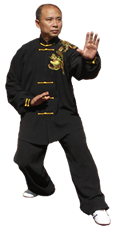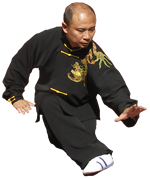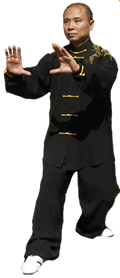
Xing Yi Quan
Xing Yi Quan (Hsing Yi Ch'uan) is one of the three major internal styles of Chinese martial arts (namely Xing Yi, Baugua And Taiji). Xing refers to form or shape and Yi commonly refers to the mind or intent. Quan [fist] denotes a method of unarmed combat. Xing Yi Quan is commonly referred to as Form and Mind boxing. The name illustrates the strong emphasis placed on the motion of the body being subordinate to conscious control. The form the body takes is an external manifestation of the internal state of mind and is the underlying premise behind Xing Yi Quan as a method of combat.
The style was originally called Xin Yi Liu He Quan [Heart Mind Six Harmonies Boxing]. The Six harmonies refer to the Three Internal Harmonies (the heart or desire harmonizes with the intent; the intent harmonizes with the Qi or vital energy; the Qi harmonizes with the physical strength), and the Three External Harmonies (the shoulders harmonize [coordinate] with the hips; the elbows harmonize with the knees; the hands harmonize with the feet). The practitioner's internal processes harmonize and coordinate the external movement, unifying the person as a whole into the most powerful state possible.
 The art of Xing Yi Quan first gain popularity in Henan, Shanxi and Hebei provinces of China, and consists of two main systems: the Animals forms and the Five Elements.
The art of Xing Yi Quan first gain popularity in Henan, Shanxi and Hebei provinces of China, and consists of two main systems: the Animals forms and the Five Elements.
The Five Element based systems have five basic forms: Splitting, Drilling, Crushing, Pounding and Crossing; these Five Elements form the foundation of the Art. The basic energies of the Five Elements are then expanded into Twelve Animal forms focus on repetitive practice of single movements that are later combined into more complicated linked forms.
The Twelve Animal Forms contain a variation in strategy and technique based on the specific animal's intrinsic nature in combat.
The direction of movement in Xing Yi forms is predominately linear. Practitioners walk through the forms coordinating the motions of their entire bodies into one focused  now. The hands, feet and torso all arrive together and the nose, lead hand and lead foot are aligned along the same vertical axis (San Jian Xiang Jiao). The arms are held in front of the body and the practitioner lines up his or her centerline with the opponent's centerline.
now. The hands, feet and torso all arrive together and the nose, lead hand and lead foot are aligned along the same vertical axis (San Jian Xiang Jiao). The arms are held in front of the body and the practitioner lines up his or her centerline with the opponent's centerline.
The techniques of Xing Yi Quan are characteristically aggressive in nature and the Xin Yi Quan fighter prefers to move into the opponent with a decisive strike at the earliest opportunity. The style prizes economy of motion and the concept of simultaneous attack and defense. As the name implies, the form or shape of the movements is only a physical manifestation of one's internal state  (intent). A fundamental principle underlying all styles of Xing Yi Quan is that the mind controls and leads the movements of the body.
(intent). A fundamental principle underlying all styles of Xing Yi Quan is that the mind controls and leads the movements of the body.
A familiar adage of Xing Yi Quan is that "the hands do not leave the [area of] the heart and the elbows do not leave the ribs." There are few kicks in the style and the techniques are predominately percussive in nature. Great emphasis is 'placed upon the ability to generate power with the whole body and focus it into one pulse which is released in a sudden burst.
Xing Yi Quan was widely practised in the north of China well before Taiji was even known outside the Chen village in Henan Province, and in the last hundred Years many full combat competitions in China was won by Xing Yi practitioners.
As well as an effective combat martial arts, Xing Yi is also an excellent health exercise. It is suitable to people of all level of physiques and ages. Movements are simple and easy to learn and practitioners can practise the arts at they own level of capabilities. It is excellent for building physical as well as mental strength.
